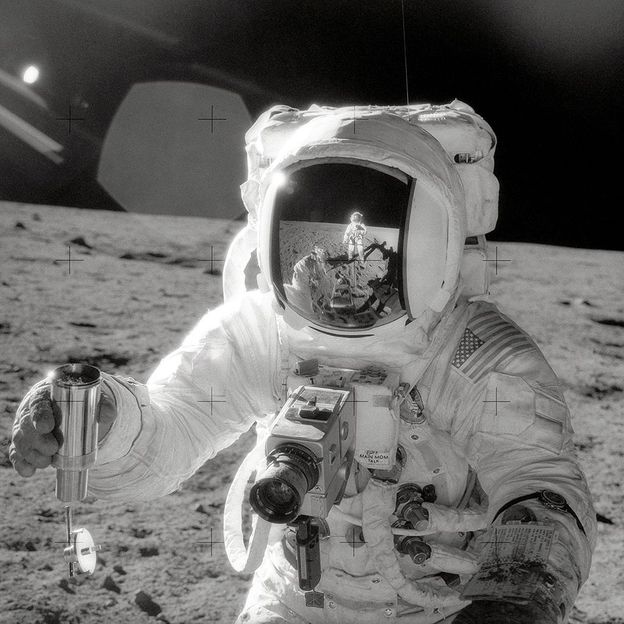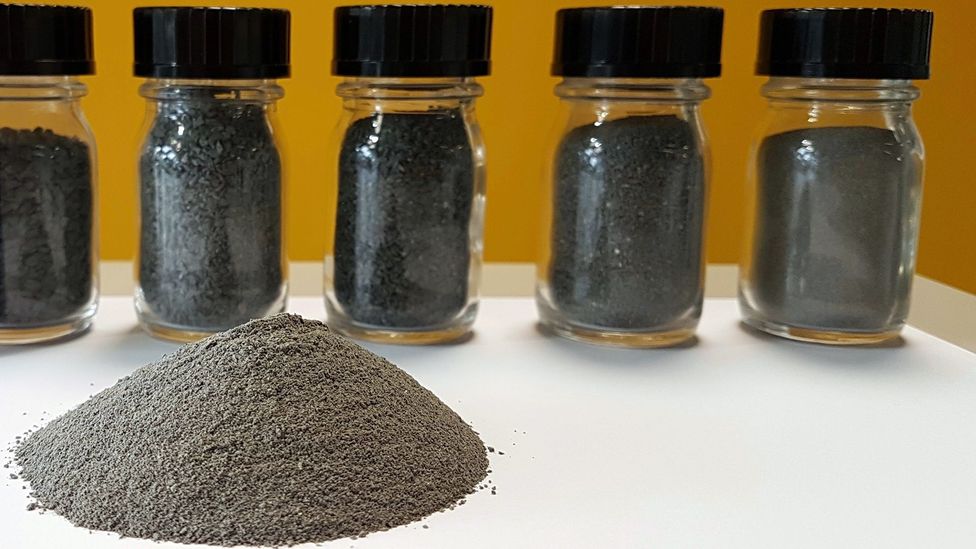Even with the walls of a volcanic crater looming behind the white-washed single-storey buildings, it would be easy to miss the sleepy town of Tao. It only takes a few moments to pass through it as you drive along the LZ-20 highway that cuts across the middle of Lanzarote, in the Canary Islands. And despite its vicinity to the Tamia volcanic crater at the heart of the island, Tao is not one of Lanzarote's key tourist attractions.
Recently, however, the town has been receiving visitors of a very different kind – those whose interest lies not in the volcano, but in the dark grey soil that Tao is built upon. This drab, rocky material has a surprising part to play in one of this decade's most ambitious human endeavours. It will help put humans back on the Moon.
A team of Spanish scientists have found that the basalt at a quarry near Tao bears a striking similarity to the samples of lunar regolith – the blanket of dusty and rocky debris covering the Moon's surface – brought back to Earth by the crew of Apollo 14 in 1971. They have used it to create a sample of lunar regolith simulant that can be used to test hardware and experiments before they are sent to the Moon.
The soil sample, called LZS-1, is the latest in a list of lunar regolith simulants of varying quality that have been developed to help Nasa and other space agencies around the world prepare for missions to the Moon.
Among the first lunar simulants to be developed was Minnesota Lunar Simulant 1 (MLS-1) at the University of Minnesota in 1988 from basalt found at an abandoned quarry in Duluth, Minnesota. Researchers discovered the rocks resembled the chemical composition of soil collected from corner of the Sea of Tranquillity visited by the Apollo 11 astronauts. The dark Mare regions, or "seas", of the Moon are composed largely of basalt rich in magnesium and iron while the lighter, highland areas are made of rocks composed mostly of calcium and aluminium.
The six Apollo missions that landed on the moon between 1969 to 1972 brought back around 380kg (837lbs) of lunar soil and rocks with them to Earth. These samples were zealously protected due to their limited availability.
"It was precious and used only for important scientific research," says John Gruener, a space scientist at the astromaterials research and exploration science division at Nasa's Johnson Space Center in Houston, Texas. Yet engineers, biologists, botanists and other research teams working on projects related to the Moon need something to test their equipment and experiments on. They require substances that replicate the physical, chemical and mineral properties of the lunar regolith, not only to see how hardware such as spacecraft and spacesuits might cope with the Moon's environment, but to test whether it might be possible to eventually grow food in the lunar soil, or use it to make building materials for constructing future lunar bases.

Relatively small amounts of lunar soil were collected by the astronauts of the Apollo missions and returned to Earth, so access to it is highly restricted (Credit: Nasa)
According to Gruener, the first real demand for lunar simulants arose after President George HW Bush's 1989 announcement of the Space Exploration Initiative (SEI), whose objective was to send humans back to the Moon and then to Mars.
The lunar dust problem
Among the challenges astronauts will face when they return to the Moon is reducing the amount of sharp dust grains that stick to their spacesuits and equipment. The tiny shards of lunar dust carry a tiny electrostatic charge, which makes them particularly clingy. Unfortunately, the dust can damage delicate equipment and electronics, so Nasa's engineers are developing new coatings they hope can prevent the lunar dust from building up on spacecraft and spacesuits, which they can then test with soil simulants.
"Unlike the Apollo missions, the SEI envisaged a longer stay on the Moon which would require new habitats, rovers and power supplies among other things," says Gruener. "We would have loved to test the new hardware on the Apollo soil and rock samples. But there was too little of it."
SEI's ambitious goals necessitated extensive testing of hardware on Earth for which large quantities of lunar soil was required. With supplies of genuine lunar soil being so limited, the only solution was to develop lunar simulants on Earth. This resulted in the birth of JSC-1, a pioneering lunar regolith simulant developed at the Johnson Space Center in the mid-1990s.
Sourced from the glass-rich basaltic ash from near the volcanic vents on the south flank of the Merriam Crater near Flagstaff in Arizona, JSC-1 was found to be similar to the samples brought back from the Moon by the Apollo 14 mission.
"It had the right mineralogy," says Gruener. "It had the correct particle size distribution. The individual particles had the right shape and crucially, the simulant had both the crystalline and glass component."
Lunar soil has a significant glass component because of the large number of high-energy meteorite impacts on its surface. The heat generated from these impacts produces glass in the lunar soil. On Earth, the main places where the soil naturally contains glass is near volcanoes. The Johnson Space Center produced around 20 tonnes (44,092lbs) of JSC-1. However, the SEI programme was later cancelled and consequently the demand for lunar simulants dwindled.
It wasn't until 2005, when President George W Bush made a speech similar to his father's by announcing the Vision for Space Exploration (VSE), whose objective was to return to the Moon and would serve as a proving ground for future missions to Mars.
Following this announcement there was renewed interest in lunar soil simulants, resulting in a series of lunar highlands soil simulants called NU-LHT which were made from anorthosite and norite rocks sourced from the Stillwater mine in Montana. However, a similar fate awaited VSE as it was shelved in 2010.
But with the birth of the Artemis programme in 2017, interest in lunar simulants has yet again been rekindled, and there is demand for a more diverse selection of lunar soil simulants to better reflect the soils astronauts might encounter at the Moon's south pole.
This time, private players are at the forefront of producing simulants. One of the world's largest producers is the Florida-based Exolith Lab which, since its founding in 2017, has produced 80 tonnes (176,370lbs) of lunar and Martian soil simulants.
You might also like:
- How to build a spacesuit fit for the Moon
- Why the Moon is making Earth days longer
- Artemis: A space programme that will break records
According to Gruener, the moon has a gritty, dusty environment. "For anything mechanical that rolls on or digs into the lunar surface, it has to encounter the regolith which is very different from anything on Earth," he says. "We [on Earth] have a lot of weathering due to wind and water which tends to round the soil particles. However, on the Moon, there is none of that. The only physical weathering is through impacts, which creates angular soil particles. As a result, things that work on Earth may not work that well on the Moon."
The regolith simulants are being used for a wide range of tests and experiments. The Johnson Space Center uses them for testing geological tools that will be driven into the rocks on the Moon, for testing the resistance of spacesuit fabrics and for developing air-purifying filters to help prevent lunar dust from contaminating the air in spacecraft and habitats.

Lunar dust has some very specific qualities that are difficult to find on Earth, so volcanic powders and rock samples that come close are highly prized (Credit: ESA)
Tonnes of lunar simulant developed by Exolith Lab will be used to test the hardware of Nasa's Viper rover, which will prospect for water on the lunar south pole. According to Exolith Lab founder Daniel Britt, simulants are also used for experiments on extracting resources like oxygen and metals.
This could be vital as space agencies look to establish a permanent settlement on the Moon – lifting raw materials from the surface of the Earth in rockets is an expensive and energy intensive business, so wherever possible, it will be important to exploit resources already to be found on the lunar surface.
So much lunar simulant might be needed as humans prepare to return to the Moon that the European Space Agency is planning to produce 900 tonnes (1.98 million lbs) of its own lunar regolith simulant, EAC-1. Most of it will be used to help train astronauts for walking on the lunar surface and put lunar rovers through their paces.
How to make a lunar soil
Rock samples, once collected, need to be milled and ground in such a way that will create angular particles. It is also important to produce the correct range of particle sizes. Usually, they do this by passing the crushed rocks through sieves with specific hole sizes.
Jesus Martinez-Frias, a planetary geologist at the Instituto de Geociencias in Madrid, who is part of the team of scientists that developed LZS-1 from the Tao quarry rocks, says they don't intend to produce quite as much of their new simulant.
"As of now, we have produced two kilograms," he says. "Our goal is to prepare high-quality material for specific research." Among the things he says it could be used for is developing ways of extracting oxygen from the lunar soil, growing crops and building structures.
While the simulants and their applications vary, there are some common guiding principles to produce them. According to Britt, the key part is to get the input materials right.
"Some of it is easy, while some like anorthosite are relatively uncommon," he says.
But Gruener says it is impossible to recreate a regolith simulant that matches 100% with the lunar soil. "We can't even recreate it at the 80% level."
According to Cowley, a simulant can't be a perfect match to the lunar soil because of the properties inherent to Earth. "For example, you will find the hydrological aspect even in rocks emerging from volcanic eruptions, such as higher sodium content compared to the lunar soil."
But if you do find a good simulant, it can be worth it. The closest matches range in price from $45 (£36) to $150 (£120) per kg (2.2lbs). Not bad for a handful of soil.
--
Join one million Future fans by liking us on Facebook, or follow us on Twitter or Instagram.
If you liked this story, sign up for the weekly bbc.com features newsletter, called "The Essential List" – a handpicked selection of stories from BBC Future, Culture, Worklife, Travel and Reel delivered to your inbox every Friday.
https://news.google.com/rss/articles/CBMiTmh0dHBzOi8vd3d3LmJiYy5jb20vZnV0dXJlL2FydGljbGUvMjAyMzA0MjQtdGhlLXBlb3BsZS1jcmVhdGluZy1mYWtlLW1vb24tZHVzdNIBAA?oc=5
2023-04-25 00:06:15Z
CBMiTmh0dHBzOi8vd3d3LmJiYy5jb20vZnV0dXJlL2FydGljbGUvMjAyMzA0MjQtdGhlLXBlb3BsZS1jcmVhdGluZy1mYWtlLW1vb24tZHVzdNIBAA
Tidak ada komentar:
Posting Komentar